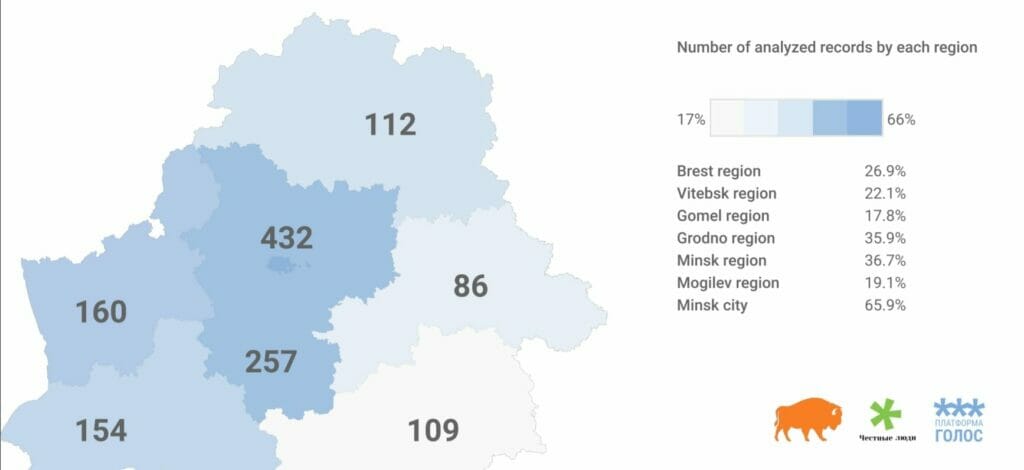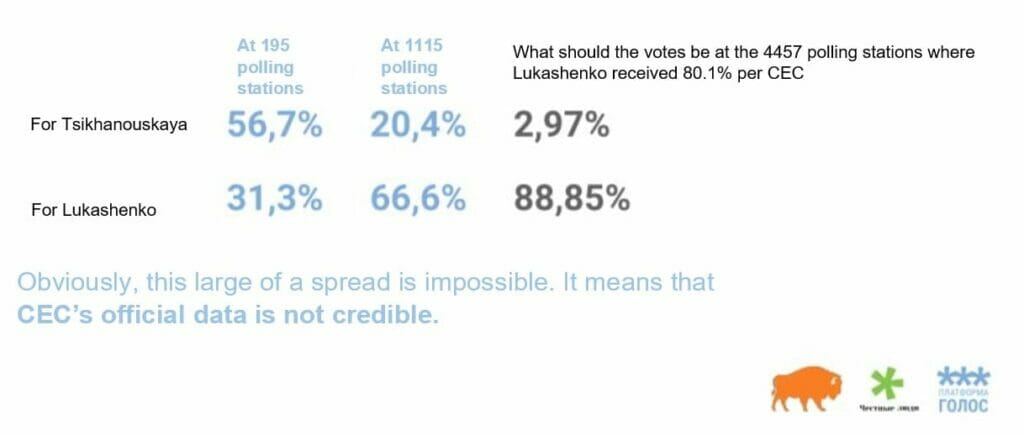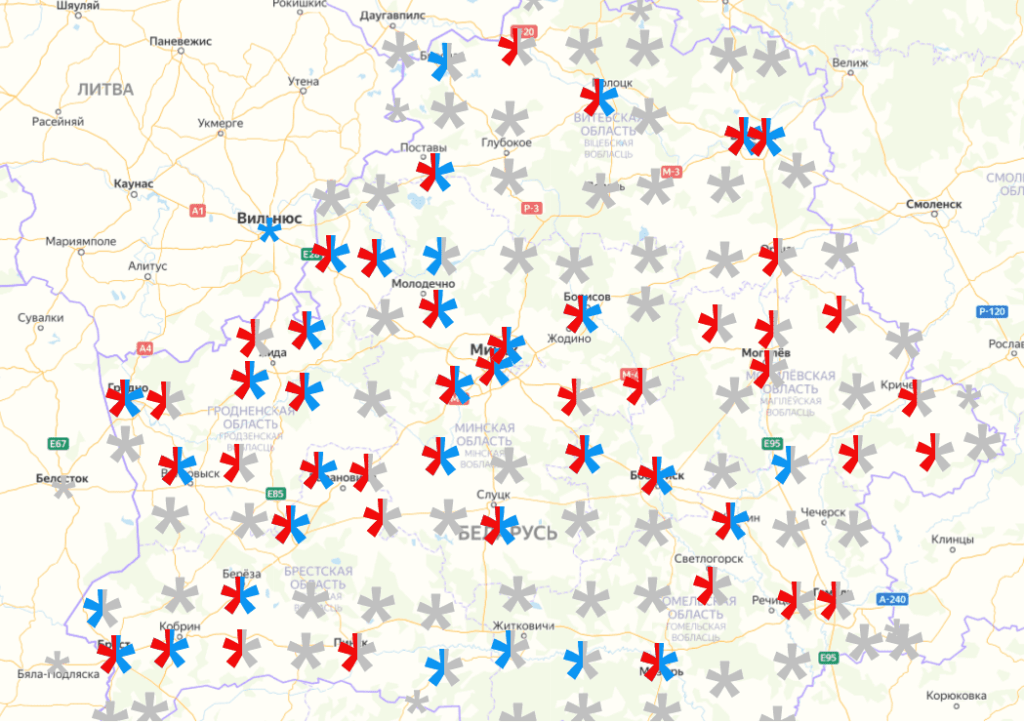20 August 2020, 18:41 | TUT.BY

The platforms Golos (Voice) and Zubr (Bison) and the Honest People initiative have presented their final report on Belarus’s presidential election. We are presenting an abridged and modified version below.
TLDR summary
The Golos, Zubr, and Honest People initiatives are arguing that, at one in three polling stations, official electoral district reports and photographs of ballots show that the number of ballots cast for one of the candidates does not match the number of votes reported for this same candidate in the Polling Station Commission’s final report.
The final data released by the Central Election Committee (CEC) differs significantly from the official data received from the polling stations. Official Polling Station Commission (PSC) data on votes for Sviatlana Tsikhanouskaya doesn’t match the information collected on the Golos platform.
How did the authors arrive at this conclusion?
Together, Golos, Zubr, and Honest People have been able to collect and process the final election result reports from 1,310 polling stations out of a total of 5,767 polling stations across Belarus. Official election result reports show 1,875,998 voters or 32.2% of the 5,818,955 who voted.
The platforms’ report reflects data obtained after processing election result reports from 1,310 polling stations, as well as the results of comparing this data with voters’ ballots available on the Golos platform.
The official election result reports available cover all regions of Belarus, as well as individual cities, towns, and villages.
“At many polling stations, the commissions did not publicly post the official election result reports. We have also identified a large number of polling stations where the election result reports were publicly posted but did not have the proper signatures or where the commissions prevented anyone from photographing the election result reports,” the report says.

What is the evidence that votes for Tsikhanouskaya were not properly counted?
“At polling stations which we have reports for, the number of votes for Sviatlana Tsikhanouskaya is on average 13 times higher than at the polling stations where reports were not obtained,” the report says.
According to the 1,310 election return reports that were received and processed, Sviatlana Tsikhanouskaya received over 81% of total votes cast in her favor, as reported by the Central Election Commission – i.e. 471,709 votes out of 588,619.
According to the election result reports which were not obtained, the presidential candidate should have received the remainder of the votes – i.e. 116,910.

At many polling stations, the commissions didn’t post the election result reports. There was also a large number of stations where the reports were posted unsigned or where commissions prevented anyone from photographing them.
This means that at the polling stations remaining unprocessed (4,457), Tsikhanouskaya should have received an average of 26 votes, which is unrealistic, considering that she received an average of 360 votes at the polling stations that had been reviewed.
Why is there a difference between the numbers on the platform and the official results?
“According to the reports pertaining to 59% of all polling stations in Minsk, Tsikhanouskaya received more votes than at the 100% of the polling stations in Minsk as reported by the CEC. This means that, in reality, more people voted for Tsikhanouskaya in Minsk than reported by the CEC. The final data reported by the CEC is completely uncorrelated with election result reports,” emphasize the report’s authors.
Thus, according to the CEC’s final official data, 126,861 voters cast ballots for Tsikhanouskaya at 731 polling stations in Minsk. Official election result reports from 432 polling stations in Minsk (representing 59% of their total number in Minsk) were analyzed. More people voted for Tsikhanouskaya at these 432 polling stations alone – 132,941 people.
The data for the Minsk region doesn’t match either. According to the CEC, in the Minsk region, 115,304 voters voted for Tsikhanouskaya at all of its 993 polling stations.
At the same time, at the 257 polling stations, whose result reports the platform had access to (26% of all the polling stations in the Minsk region), Tsikhanouskaya received 114,553 votes or 99.3% of the number reported by the CEC. It means the remaining 74% of polling stations would have collected the other 0.7% of the votes for Tsikhanouskaya.

Why couldn’t Lukashenko have received 80% of the votes?
According to the CEC results, 80.1% of Belarusian voters cast ballots for Alexander Lukashenko.
However, according to official PSC election result reports received from 1,310 polling stations, candidate Alexander Lukashenko obtained about 61.7% of the votes, which is significantly lower than the CEC-reported result of 80.1%.

Keeping in mind that at one-third of the polling stations the final PSC election result reports showed a discrepancy between the number of ballots and the number of votes for the same candidate, one can draw the conclusion that even the 61.7% result isn’t accurate.
Matching the data from official PSC election result reports with pictures of ballots on the Golos platform helped identify inconsistencies at at least 440 of these 1,310 polling stations.
Why does Golos think we shouldn’t trust the CEC data?
The 1,310 official election result reports presented on the platform contain conflicting data.
According to official data from PSC’s final reports, Lukashenko won at 1,115 polling stations, Tsikhanouskaya – at 195 polling stations.
● At the 195 polling stations where Tsikhanouskaya officially won, she received, on average, 56.7% of the votes. Lukashenko received only 31.3% at the same polling stations.
● At the 1,115 polling stations where Lukashenko officially won, he obtained an average of 66.6%. Tsikhanouskaya received only 20.4% at the same polling stations.
● The remaining 4,457 polling stations account for 3,942,957 voters. According to the official CEC results, their votes were split as follows: 116,910 voted for Sviatlana Tsikhanouskaya and 3,503,283 for Alexander Lukashenko.
“According to the CEC then, this means that Tsikhanouskaya received an average of just 2.97% of the votes at the remaining 4,457 polling stations, while Lukashenko receives a fantastic 88.85%. This would mean (if we were to assume the CEC data is accurate) that the random 1,310 result reports we received are absolutely extraordinary and fundamentally differ from the other 4,457 result reports,” write the authors of the report.

What is Golos’ final data?
1,261,127 users registered and voted on Golos. 1,047,933 verified their phone numbers as a way to prove their votes reflected their actual choices. As of August 18, voters submitted over 550,000 photographed ballots to the platform.
Ballot photographs are used to identify inconsistencies at electoral polling stations. If the number of ballots for a candidate exceeds the number of votes reported in the PSC’s final election result report for the same candidate it should be cause for concern.
Inconsistencies were found at 30% of the polling stations from which ballots have been submitted to the Golos platform – those are the polling stations where there were more votes for the candidate Sviatlana Tsikhanouskaya as confirmed by the photos of ballots than were recorded in the PSC election result reports.
At least 30% of the election result reports used in the analysis have been deemed inaccurate.
The platform website has a map. Polling stations in blue are those where both the commission’s report and Golos data show the same winning candidate. Polling stations in red are those where there were more votes for a candidate on Golos than in the official reports. Those in grey are the ones with not enough data available to draw conclusions about the integrity of the election commission’s work.

Here are the votes of users who verified their phone numbers:

We would also like to note that Golos platform has a mirror site at partizan-results.com with a map of polling stations. On the map, voters can see polling stations where data from Golos diverges from the official PSC data (photos of ballots are currently being published and will be posted for all the polling stations on August 21).
We described this in detail in our other article.
What data does the Zubr platform have?
The Zubr platform has become the single collection point for information about violations submitted by independent observers during the election campaign.
To date, the platform has collected 6,532 unique reports from 1,403 polling stations that contain 3,988 photos, video, and audio recordings and 5,955 descriptions.
● Discrepancy in the number of voters: 822.
● Accredited observers denied entry: 817.
● Voters denied entry to the polling station: 705.
● Restriction of observers’ rights: 563.
● Non-compliance with election result report posting deadlines: 240.
● Non-transparent counting: 167.
● Voter coercion: 36.
● Other: 3,660.
Information about all the violations is available on the Zubr platform. The website is not available in Belarus, so it requires the VPN for access.
Other references:
Final PSC election result reports with photos, collected by the Honest People initiative and the Zubr platform – here.
The map from the Golos platform with a list of polling stations for which there were more photos of ballots received than there were votes recorded by the official election result reports – here.
Update on the Golos platform situation
On August 6 Alexander Lukashenko ordered an assessment of the legality of initiatives aimed at providing an alternate vote count.
“Another topic worth paying attention to is the alternate vote counting on election day. Both the Prosecutor General’s Office and the courts should assess the legality of these initiatives. The courts should decide, in case requests are filed,” he said.
On the same day the head of the CEC Lidzija Jarmoshyna delivered a video address. She expressed regret that „a political scam called the Golos internet platform” is being introduced in our country.
“Essentially, it is a shadow CEC,” said the head of the CEC, calling the platform „a harmful and criminal project.”
“We are being assured that its aim is to monitor the expression of the will of the voters. No, my darlings, this is not to monitor it. This is to create a distorted outcome of the election to undermine the official result of the vote and to use this to organize mass civil unrest. This is why it’s being done,” Jarmoshyna shared.
The project team responded to the CEC head, noting that Golos platform’s only goal is to check to make sure that the official results are reliable. It is a non-partisan service that doesn’t campaign for any of the candidates and can’t distort the election results. After Lukashenko and Jarmoshyna’s statements, the Prosecutor General’s Office determined that the Golos and Zubr.in online platforms are engaged in conducting opinion polls and research without accreditation by encouraging their users to take pictures of ballots at polling stations, submit them, and participate in alternate vote counting. Its founders face administrative offense charges.